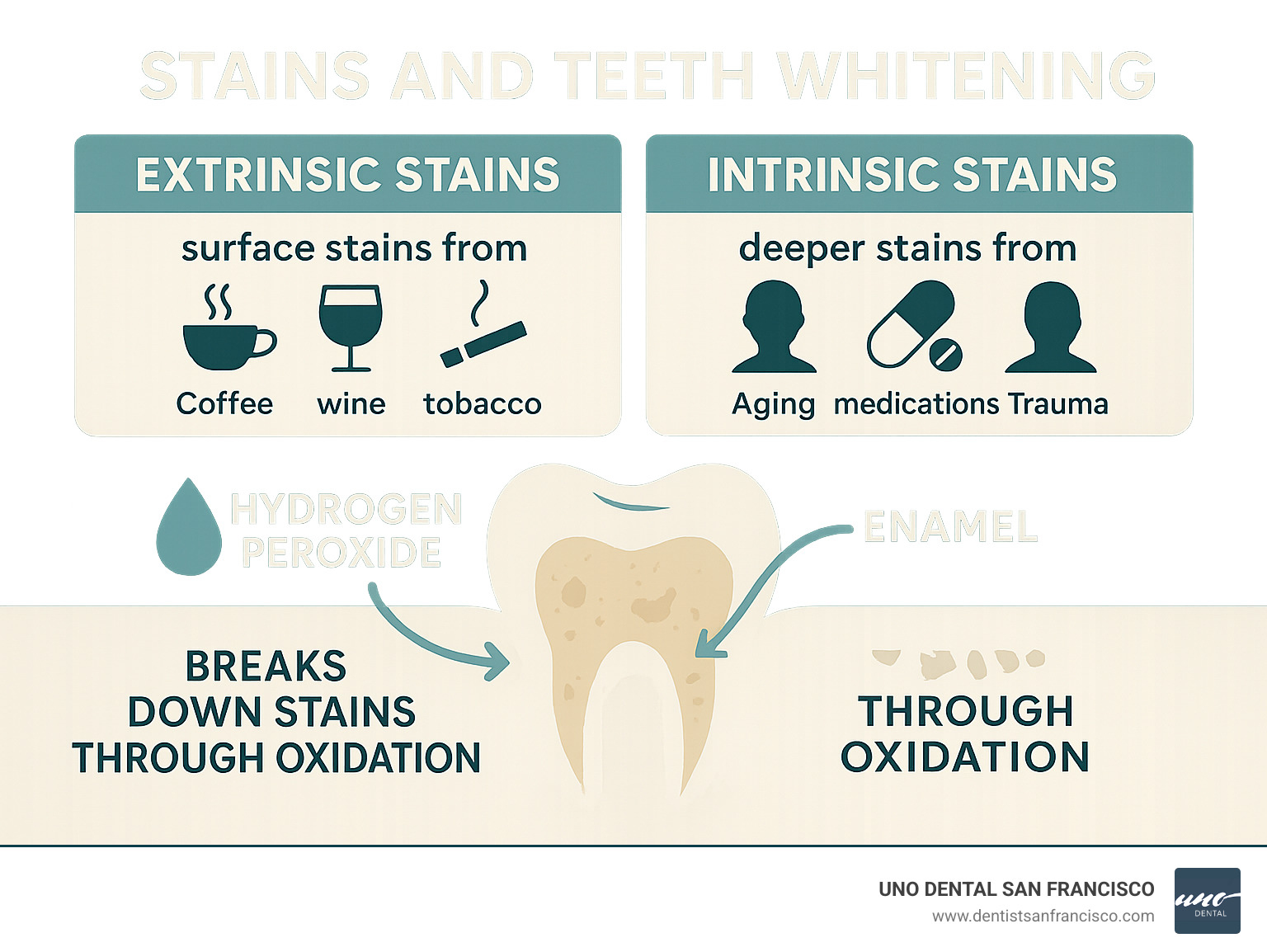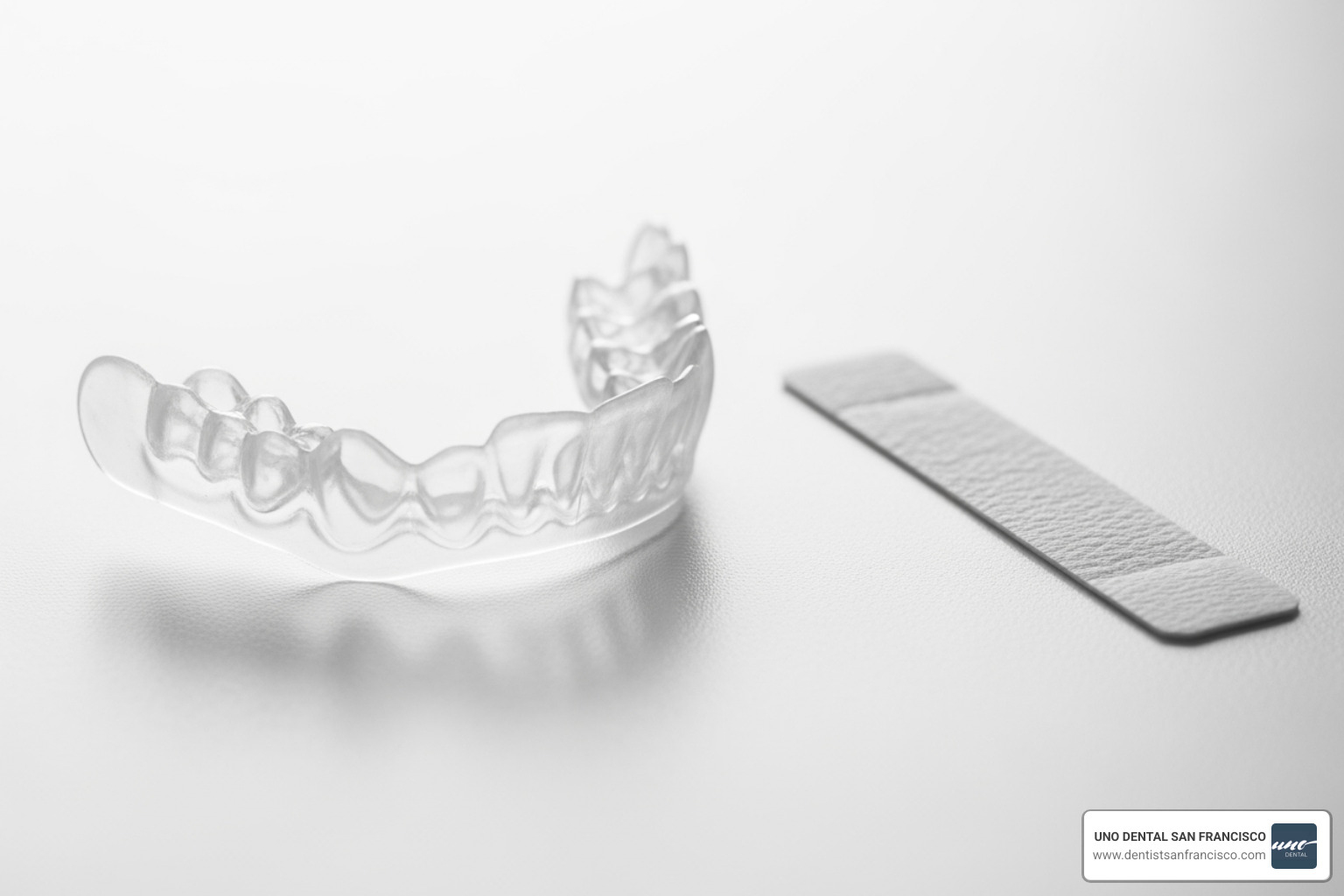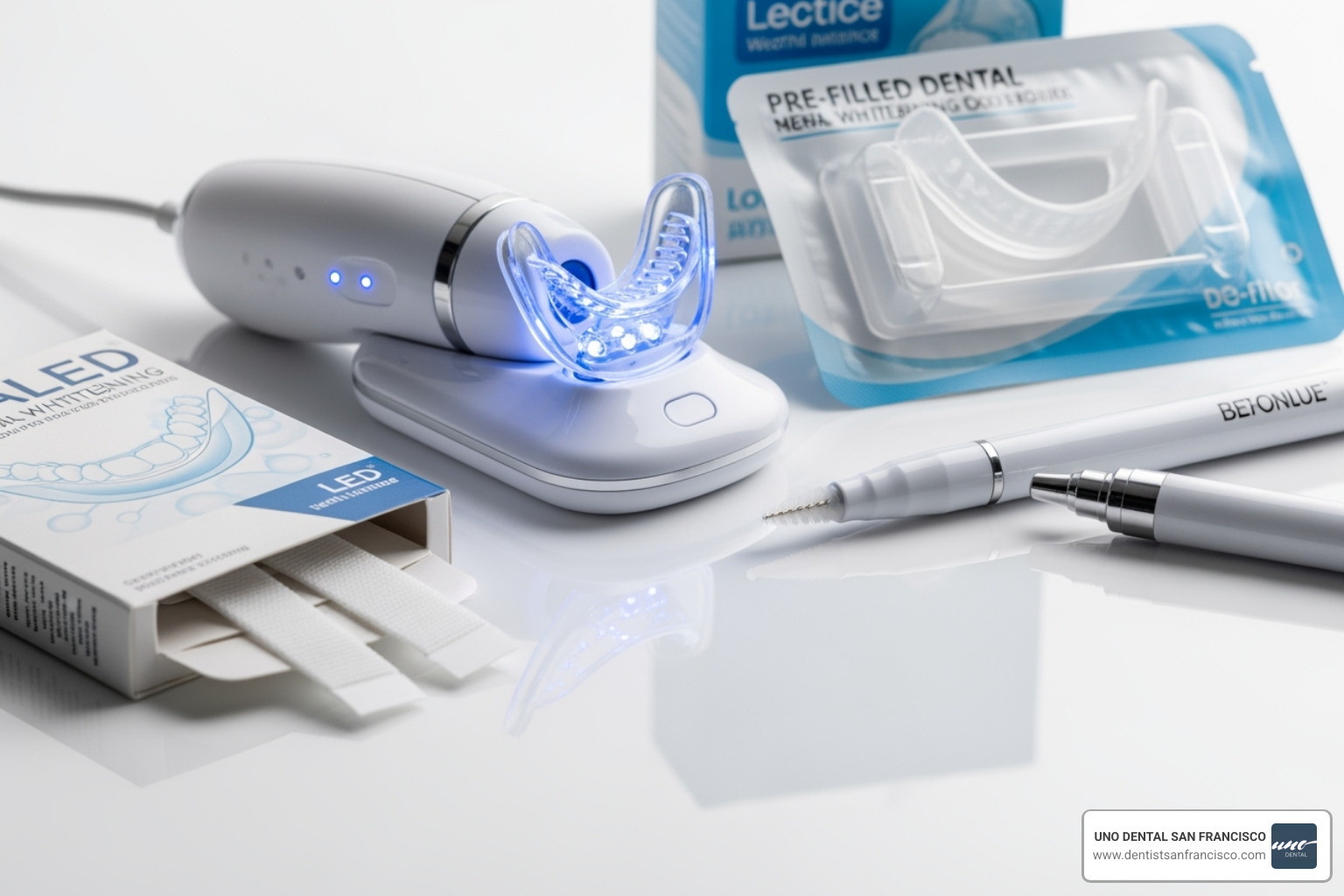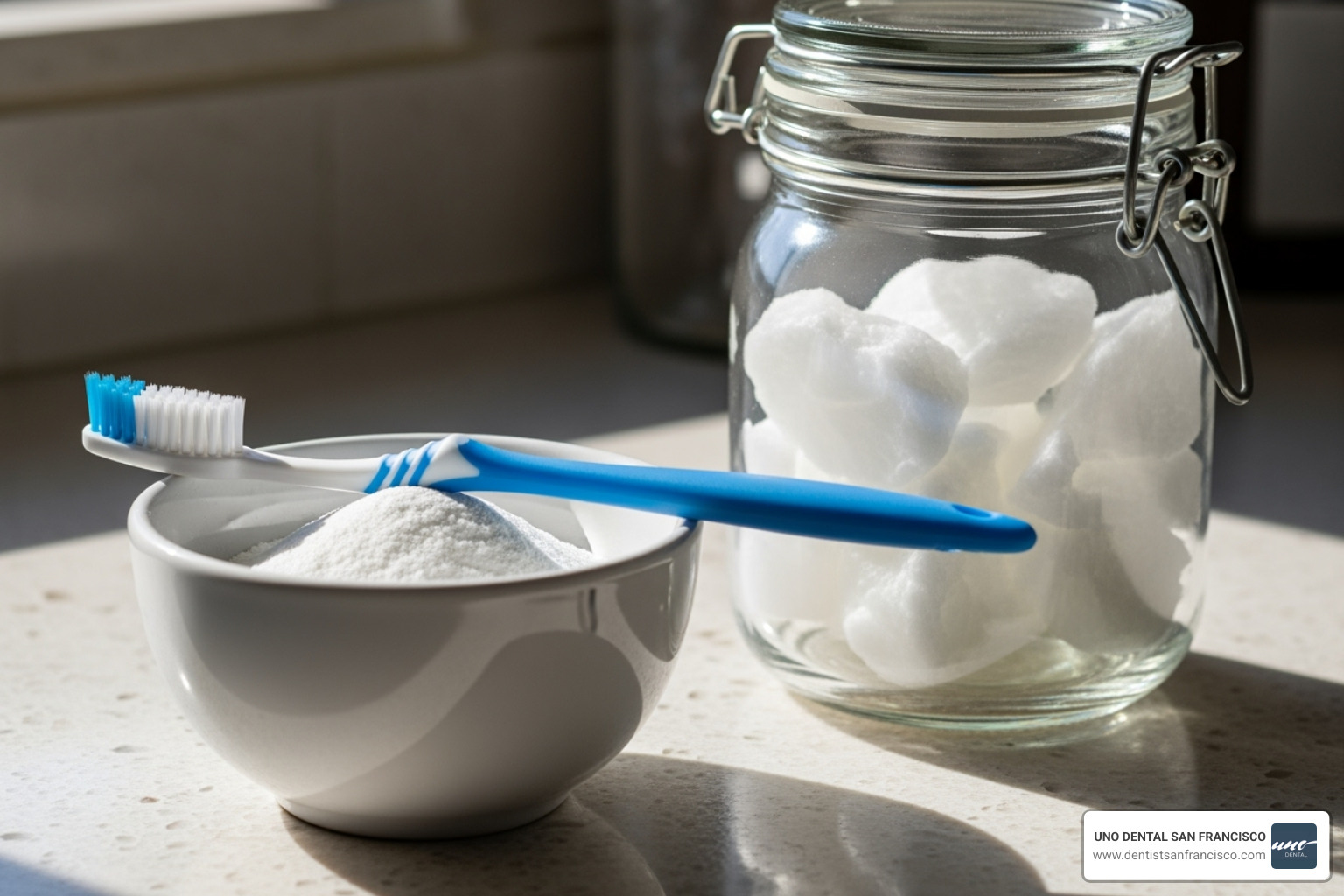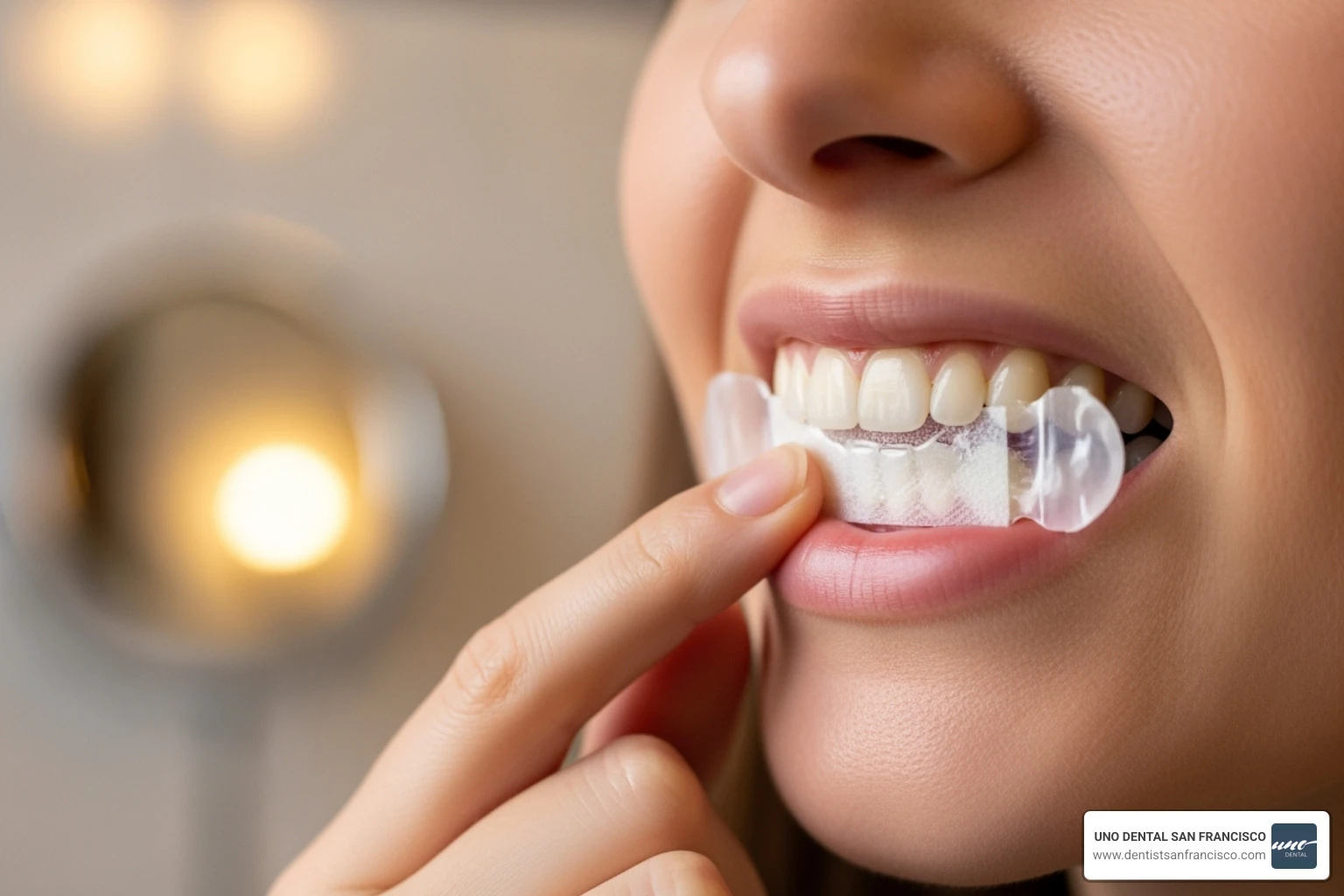
Your Journey to a Brighter Smile Starts Here
Dental whitening at home offers a convenient way to achieve a brighter smile. With the market for these products growing, it's clear that people value the ability to whiten their teeth on their own schedule. However, not all at-home methods are created equal in terms of effectiveness or safety.
Quick Answer: Most Effective At-Home Whitening Methods
- Professional take-home kits with custom trays (most effective)
- Adhesive gel strips with hydrogen peroxide (moderate effectiveness)
- LED whitening kits with peroxide gel (slightly more effective than adhesive gel strips)
- Whitening pens for touch-ups (least effective for full whitening)
While at-home products can lighten teeth by one to two shades, professional treatments often yield more dramatic results. Your top priority should always be safety. Understanding the ingredients and methods is key to making an informed choice.
As Dr. Mohammad Aghiad Kandar, DDS, with over 15 years of experience in cosmetic dentistry at UNO DENTAL SAN FRANCISCO, I've helped countless patients steer their dental whitening at home options safely. My expertise in creating customized treatment plans ensures you achieve the brightest smile possible while protecting your enamel and overall oral health.
Understanding Your Options for Dental Whitening at Home
Starting your journey to a brighter smile means understanding the landscape of dental whitening at home options. From professional take-home kits prescribed by your dentist to over-the-counter products, each method offers a unique approach. We'll explore the science, compare effectiveness, and discuss safety to help you choose the best path for your smile.
Comparing At-Home Kits vs. Professional Treatments
When considering dental whitening at home, it's important to weigh the differences between over-the-counter products and professional take-home kits from a dentist.
- Effectiveness: Professional treatments use higher concentrations of bleaching agents, delivering more noticeable results than most store-bought kits, which typically lighten teeth by only one to two shades.
- Safety and Supervision: This is where professional oversight is critical. At UNO DENTAL SAN FRANCISCO, we first assess your oral health for issues like cavities or gum disease that could be worsened by whitening. This personalized approach minimizes risks like sensitivity and gum irritation.
- Custom-Fit Trays: Our professional kits use custom-made trays created from impressions of your teeth. This ensures the whitening gel is applied evenly and prevents it from leaking onto your gums, a common issue with ill-fitting, one-size-fits-all trays.
- Peroxide Concentration: We help you find the right balance of peroxide concentration for effective yet comfortable results, something you can't get from a box.
- Cost-Effectiveness: While professional kits may have a higher initial cost, their superior results and safety offer significant value. They provide a great balance of effectiveness and affordability for long-lasting brightness.
For more information about our professional teeth whitening services and how we can tailor a plan just for you, please visit our dedicated page: More info about our professional teeth whitening services.
Key Ingredients to Look For (and Avoid)
Understanding the ingredients in dental whitening at home products is crucial for both effectiveness and safety.
Effective Whitening Agents:
- Hydrogen Peroxide (HP): The most common active ingredient. It releases oxygen molecules that penetrate enamel to break down stains.
- Carbamide Peroxide (CP): A stable compound that breaks down into hydrogen peroxide more slowly, which can result in less sensitivity for some users.
Ingredients for Sensitivity Management:
Many quality products now include ingredients to combat the common side effect of tooth sensitivity:
- Potassium Nitrate: Calms the nerves inside the tooth to reduce sensitivity.
- Fluoride: Strengthens enamel.
- Hydroxyapatite: This mineral, which is the main component of tooth enamel, can help remineralize and strengthen teeth during the whitening process, reducing sensitivity. You can learn more about the science here: Scientific research on Tooth Whitening with Hydroxyapatite.
Ingredients to AVOID (Harmful DIYs):
Many internet remedies can cause irreversible damage to your teeth.
- Acidic Fruits (Lemon Juice, Vinegar): These are highly acidic and can erode tooth enamel, leading to sensitivity, decay, and a more yellow appearance over time as the underlying dentin is exposed.
- Abrasives (Activated Charcoal, Baking Soda Overuse): While they can scrub away surface stains, abrasive materials can also wear down your enamel over time. Use them with extreme caution, if at all.
At UNO DENTAL SAN FRANCISCO, we prioritize your long-term oral health over temporary trends.
A Guide to Popular At-Home Whitening Products
The market for dental whitening at home offers a wide array of products. Here’s a look at the most common types and what you can generally expect from them.
| Product Type | Typical Results | Treatment Time | Ease of Use | Best For |
|---|---|---|---|---|
| Adhesive Gel Strips | 1-2 shades lighter | 30-60 minutes daily for 7-14 days | Very easy, but can be slippery/messy | Gradual, moderate whitening; convenient for those new to whitening. |
| LED Kits | 1-2 shades lighter (slightly better than adhesive gel strips/trays) | 10-30 minutes daily for 5-10 days | Moderately easy; device needs charging | Faster results; the light may accelerate the gel's effects. |
| Prefilled Trays | 1-2 shades lighter | 15-60 minutes daily for 5-10 days | Easy, no gel application needed | Convenient, pre-measured doses; a good middle-ground between adhesive gel strips and custom trays. |
| Whitening Pens | Up to 1 shade lighter (touch-ups) | 1-2 minutes per application, as needed | Very easy, portable | Quick touch-ups and spot treatments to maintain results. |
- Adhesive Gel Strips: These are thin, flexible strips coated with a peroxide-based gel that you apply directly to your teeth. They are easy to use but can be messy and may not cover all tooth surfaces evenly.
- LED Kits: These kits pair a whitening gel with a blue LED light. The light is intended to accelerate the chemical reaction of the peroxide, potentially leading to faster results. The gel itself does the whitening.
- Prefilled Trays: These are generic, pre-loaded trays that offer a simple, mess-free application. However, their one-size-fits-all nature can lead to uneven results and gum irritation.
- Whitening Pens: These are best for on-the-go touch-ups. A brush-tip applicator dispenses a small amount of gel, making them ideal for maintaining results or targeting specific spots.
While these products offer convenience, for the most effective and safest results, a professional take-home kit with custom-fit trays remains the superior option.
The Truth About Natural Dental Whitening at Home Remedies
Many people explore natural remedies for dental whitening at home, but it's crucial to separate fact from fiction to avoid damaging your teeth.
- Baking Soda: As a mild abrasive, baking soda can help remove surface stains. However, overuse can lead to enamel erosion. If used, it should be done sparingly and only with water.
- Oil Pulling: Swishing with coconut oil may help reduce plaque and bacteria, which supports overall oral health and can help prevent new stains. However, scientific evidence showing it can whiten existing stains is limited. It is not a bleaching agent. Limited evidence suggests oil pulling may reduce plaque.
- Crunchy Fruits and Vegetables: Foods like apples and carrots can help scrub away food particles as you chew, but their whitening effect is minimal.
Harmful Remedies to Avoid:
- Activated Charcoal: This popular trend is highly abrasive and can wear down enamel, leading to sensitivity and making teeth appear more yellow over time.
- Fruit Acids (Lemon Juice, Vinegar): The high acid content in these substances can severely erode tooth enamel, which does not grow back. This causes permanent damage.
- Turmeric: This spice is more likely to stain your teeth yellow than to whiten them.
For safe and genuine whitening, it's best to rely on scientifically proven methods under dental guidance rather than unproven DIY trends.
Best Practices for a Brighter, Healthier Smile
Achieving a white smile with dental whitening at home is just the first step. Maintaining those results requires consistent care and smart habits to keep your smile sparkling for months to come.
Maintaining Your Whitening Results
Protect your investment with a solid stain-prevention game plan. With good habits, your results can last from six to twelve months or even longer.
- Avoid Staining Culprits: Limit your intake of coffee, red wine, dark teas, colas, and richly colored foods like berries and tomato sauce. Tobacco use is particularly damaging and will quickly reverse your results.
- Use a Straw: When drinking staining beverages, use a straw to minimize contact with your front teeth.
- Rinse and Wait: Rinse your mouth with water after consuming staining foods or drinks. If you've had something acidic, wait 30-60 minutes before brushing to protect your temporarily softened enamel.
- Practice Excellent Oral Hygiene: Brush twice daily for two minutes and floss daily. This prevents the plaque buildup that makes teeth look yellow.
- Schedule Regular Cleanings: Professional cleanings remove stubborn tartar that absorbs stains. This is crucial for maintaining brightness and overall oral health. Explore our preventive dentistry services to support your smile.
- Eat for Enamel Health: Calcium-rich foods like milk, cheese, and broccoli help build strong enamel that resists stains.
When to Consult a Dentist Before Dental Whitening at Home
While convenient, dental whitening at home isn't safe for everyone. A consultation with a dentist is essential to avoid painful or disappointing results, especially if you have certain conditions.
Seek Professional Advice If You Have:
- Pre-existing Dental Issues: Whitening agents can cause severe pain if they seep into untreated cavities or irritate inflamed gums from gum disease.
- Thin Enamel or Tooth Damage: If your enamel is thin or you have cracks in your teeth, you are at high risk for extreme sensitivity.
- Existing Tooth Sensitivity: Whitening will likely worsen sensitivity to hot and cold. We can recommend ways to manage this.
- Dental Restorations: Crowns, veneers, fillings, and bonding will not change color. Whitening your natural teeth can create an obvious and unsightly mismatch.
An initial dental exam is the most important step. We can identify hidden issues, ensure your teeth are clean for the best results, and set realistic expectations. Starting with a healthy foundation is key to achieving a beautiful, even smile safely.
At UNO DENTAL SAN FRANCISCO, we believe in a personalized approach. Our virtual smile consultation is a convenient way to determine the safest and most effective dental whitening at home plan for your unique needs.
